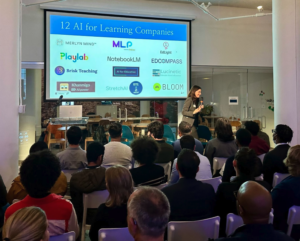Q&A: Nancy Hoffman On Vocational Education
 This November, Getting Smart reviewed Nancy Hoffman’s book Schooling in the Workplace: How Six of the World’s Best Vocational Education Systems Prepare Young People for Jobs and Life, a book that explores best practice examples of vocational education practices around the world.
This November, Getting Smart reviewed Nancy Hoffman’s book Schooling in the Workplace: How Six of the World’s Best Vocational Education Systems Prepare Young People for Jobs and Life, a book that explores best practice examples of vocational education practices around the world.
Hoffman is a Vice President and Senior Advisor at Jobs for the Future, a national non-profit in Boston, the mission of which is to improve educational and workforce outcomes for low-income young people and adults. She works on early college designs, and the transition to and through postsecondary credentials. Hoffman serves as a consultant for the Education and Training Policy unit of the Organization for Economic Cooperation and Development (OECD).
In her book, Hoffman outlines the ways that vocational education and training (VET), which couples hands-on work experience and traditional learning to develop 21st century skills, can better prepare students for higher education and life. In the Q&A below, Hoffman discusses the outlook of VET programs around the world, the differences in the US and the challenges Americans face in producing comparable programs for students.
Q: What is VET?
A: VET (vocational education and training) is one of two educational pathways between which young people chose at around age 15 in most European countries. The other is the academic pathway to university reserved for students wishing research, academic careers and professions such as medicine and law. The purpose of VET is to build a transition from school to learning-to-work to fulltime work over a period of three of four years. The goal is for participants to get training for an initial career and enter the workforce smoothly with the option to continue their studies in postsecondary institutions if they wish. The best VET approaches integrate work and learning in a partnership with what are called “social partners” — employers, unions, educators, and the state.
The state takes responsibility for ensuring that the education is broad and that the students get portable skills. Students generally spend two days in school and three in a company working to develop competencies that will qualify them for permanent employment. Switzerland, Germany, Austria, Australia, and several Nordic countries educate from 40 percent to 75 percent of their young people in this system. In a number of countries, VET is the smartest and quickest route to a wide variety of occupations for the majority of young people in the successful countries—not a default for failing students. Young people realize that technical skills like IT, engineering, graphic design and the like are better learned on the job than first as theory as in a university setting, and then applied later on during a first job.
Q: What is the success rate of VET programs across the globe?
A: I can only report on the countries I studied and that are included in Learning for Jobs, the OECD 17-country study which got me started on this work. We can say this: Countries with strong vocational education and training (VET) pathways have the highest rates of upper secondary completion and the lowest youth unemployment. VET appears to keep students in school who might otherwise drop out, although it is true that VET in general has lower completion rates than the academic pathway.
Austria, Germany, and Switzerland, for example, have the majority of students in their VET systems and have graduation rates above 90 percent. These countries have also kept their youth unemployment rates between five and eight percent in the economic crisis while US rates have risen to 20 percent. Bottom line is that countries with strong VET systems have almost everyone in school through age 18 or 19 attaining work experience or preparing for university. Compared with these countries, the US is a shameful failure with high school drop out rates in our cities of 50 percent. In addition, upper secondary completion in VET countries is more like the completion of an AA degree than high school.
Q: How is VET around the world different than work study or internship programs in the Unite States?
A: I love the phrase, “the school is not the center of the world,” which came from a report written by a group from Moldova a on a study tour to Switzerland to learn about the Swiss VET system, arguably the best in the world. They write that “the Swiss Education system was presented… with … emphasis on the fact that ‘the school is not the center of the world;’ it is just a service-providing institution that should meet the client’s needs. The future apprentices think less about which school to go to and ore about learning occupation in order to get a good job.”
I love the phrase, “the school is not the center of the world.”
Work-study and internships are additions to full-time schooling, not the main locus of schooling. To come at this a different way, in strong VET systems, the state establishes the legal framework for VET through a Vocational Training Act, setting up a tripartite governance structure: 1) the representative bodies established by the social partners (employers and unions) 2) the state (ministries, education boards at national and regional levels), and 3) VET providers (schools, state or regional entities). The institutional framework sets out the roles of all stakeholders, the qualifications for teachers and trainers, the way VET is assessed, and how quality is controlled. Such a legal document leaves little ambiguity about decision-making and power sharing in specific realms. Within the legal framework, the foundational document is the apprenticeship or traineeship contract that sets out the rights and obligations of both trainees and the firms receiving them. This is an education system, not an “add on” internship or work-study program.
Q: What is the current rate of VET-type programs (work study, internships) in the United States for K-12 and college-level students?
A: Work-study and internships are not what VET is about as I point out above. Both are useful experiences for students, but in the non-US programs that I’m describing, students learn primarily at work, their applied learning is assessed there, and the school learning is integrated with it. They exit school qualified for a calling and with substantial work experience, often doing a full, productive job as they complete their three or four years in the workplace and they get a stipend for their work. The stipend usually starts at a percentage of the regular wage (in Switzerland around $800 a month for a 16-year old), but reaches full wages by the third year or nearly full wages.
The US would show up as having no VET or career and technical education (CTE) at all.
As for the US, one piece of data that may surprise readers is that when the OECD charts the proportion of students across countries engaged in vocational education and training as opposed to academic general education, the United States is not on the chart. The US would show up as having no VET or career and technical education (CTE) at all. This is because while about one in five high school students concentrate in an occupational area, the course requirements are a small proportion of the high school diploma. Precedence goes to being “college and career ready.” High school CTE has as its purpose to allow students to explore a career and to motivate and engage at risk students to stay in school, while providing the basic math, reading, and writing skills required for postsecondary education. While CTE programs in low-performing districts tend to have higher high school completion rates than the non-CTE curriculum that is a very low bar. For a host of reasons explored in my book—not the least of which is that too many young people go off to college unprepared and bored with the prospect of more school—CTE could be doing much more, and not just for struggling students.
Community college students do have internships and clinical experiences; these are required for licensure or to earn a certificate in a number of career areas, most notably the health professions. If you are following some of the exposes of for-profit career schools, one rap against some is that to get a job you need a specific number of hours of clinical experience, which these schools promise to provide, but in fact, do not. Nursing programs do a great job of teaching students on site in hospitals and clinics, for example. The approach, however, is not incorporated or required in most career areas, and not in community college transfer degrees.
Q: What are the major policy obstacles or challenges in the United States that prevent schools or universities from implementing a VET program?
A: First of all, the US does not have youth policies that protect and support the younger generation as other countries do. I despair when I think about the prospects of the “forgotten half,” those young Americans who—for reasons of poverty, poor quality high school education, no faith in the future, lack of engagement in traditional schooling—are adrift in a harsh economy with no structures or supports as they grow from being adolescents at school into adulthood. Compared with other relatively strong economies, the US pays youth low wages, has little job protection, and provides few social and income supports for young people struggling with schooling and employment. More specifically, there are obstacles to engaging younger students in work because of unions’ and others’ objections to training wages, a lower wage for students learning on the job.
I despair when I think about the prospects of the “forgotten half.”
In addition, we do not provide income supports to young people and so cannot use these as “carrots” to incentivize young people to be in a mix of school and work until they get a credential. Called “activation policies,” these entail agreements or compacts among young people, their families, and the government that the young person will actively seek work and stay in training in exchange for targeted actions to help them. Income supports and other services are in jeopardy if the young person refuses services, or does not keep her side of the bargain in participation. Finally, our notion that all students need to be college and career ready and these are the same thing has created a disincentive for schools to provide career counseling, to teach high school students about work options, and to do more than get every one essential academic skills which are important, but aren’t the whole picture.
Q: How can we best overcome these challenges?
A: That’s a tough question. You might suggest that your readers take a look at the Pathways to Prosperity report, which draws lessons from the models I’ve been describing, but is written to encourage US educators and policy makers to address the lack of pathways to careers in the United States. The Pathways to Prosperity Project, which is based at the Harvard Graduate School of Education (HGSE), examines the reasons for our failure to prepare so many young adults, and advances a vision for how the United States might regain the leadership in educational attainment it held for over a century. The report argues that our national strategy for education and youth development has been too narrowly focused on an academic, classroom-based approach and advocates development of a comprehensive pathways network to serve youth in high school and beyond.
When the report appeared last February, it generated considerable heat by contending that at present, we place far too much emphasis on a single pathway to success: attending and graduating from a four-year college. The report notes that while the United States is expected to create 47 million jobs in the 10-year period ending in 2018, only a third of these jobs will require a bachelor’s or higher degree. The report argues we need to broaden the range of high-quality pathways that we offer young adults. This would include far more emphasis on career counseling and high-quality career education, as well as apprenticeship programs and community colleges as viable routes to well-paying jobs.
I’ve drawn on the news release from HGSE (February 2, 2011) for the description above. Full disclosure requires me to say that one of the authors of the Pathways report is my husband, Bob Schwartz, who has joined me in the OECD work, teaches education policy at the Harvard Graduate School of Education, and was the founder of Achieve, Inc. He and I have had a long interest in workplace learning. You can find the report on line.
Q: How do you envision VET programs in the United States in the future?
A: The United States is not without excellent high school CTE models some replicated at considerable scale, and most with aspirations for both career and college readiness as the outcome. And many community colleges mount certificate and degree programs with clinical or internship requirements that do get completers excellent starting jobs. Indeed, evidence is growing that if you choose the right AA or AAS degree, you can earn more than a good proportion of college graduates. Recent data from Florida, for example, shows that graduates with two-year Associate in Science degrees earned $10,357 more on average than baccalaureate graduates of the State University System.[i] Known and admired abroad for its inventiveness and entrepreneurial spirit in education and especially for, the US has pockets of excellent. We just don’t have a system.
A couple of examples to build on might be helpful. At the high school level cutting-edge career and technical education (CTE) bears little relationship to traditional vocational education programs that are sometimes little more than schools of last resort for students who were not going to succeed in college-prep. National initiatives such as Career Academies, Project Lead the Way, High Schools that Work, and Linked Learning– a more recent California initiative– combine the broad academic foundation needed for further education with some depth of study in a career area.
The newest of the modernized CTE models is Linked Learning, an ambitious California initiative which goes beyond career exploration in high school to provide engaging career concentration in areas in high demand in specific labor markets in the state– engineering, biomedical and health sciences, energy, information technology, manufacturing, natural resources and the like. Linked Learning has developed integrated and interdisciplinary curriculum and pathways into postsecondary.
Two high performing school networks for high school age young people—Cristo Rey and Year Up—have commonalities with European apprenticeships: substantial work experience is a requirement for everyone, and students are socialized to understand and perform well in a business culture. Organized through its Corporate Work Study Program, Cristo Rey students work one day a week in hospitals, universities, law firms, research labs, and private businesses. Serving high school graduates ages 18 to 24 entering with weak skills, the yearlong Year Up program provides technical and professional skills, college credits, an educational stipend and a six-month corporate internship.
In addition, states are also linking high school and postsecondary education to support college level credit in high school through dual enrollment and accelerated whole school models such as early college high schools. The recent rapid growth in dual enrollment programs, and the promising development of the national network of some 250 Early College High Schools (ECHS) suggest that some of the barriers that have prevented better cooperation across the secondary/post-secondary boundary are beginning to break down. My organization, Jobs for the Future, has been the national intermediary for early colleges, and sees considerable promise there. About 77,000 young people now attend early college high schools, the majority of them low-income students and students of color. Over 40 percent are graduating from high school with at least one year of college credit, and nearly a quarter with an AA degree. About one third of the programs have a STEM focus with young people equipped to enter the job market after the AA if they want to. North Carolina’s early college high schools offer an ECHS STEM and career-focused models with strong political support and employer participation that other states and districts could adapt to suit their education and employment needs. This is the direction we should be taking, but a huge challenge that has never been met in the US is to engage employers.
—
Hoffman also wrote the recent books including Women’s True Profession: Voices from the History of Teaching (2003), Double the Numbers: Increasing Postsecondary Credentials for Underrepresented Youth (2004)(with Kazis and Vargas), and Minding the Gap: Why Integrating High School with College Makes Sense and How to Do It (2007), (with Vargas, Venezia, and Miller), and Learning for Jobs. Hoffman serves on the Massachusetts Board of Higher Education.





0 Comments
Leave a Comment
Your email address will not be published. All fields are required.